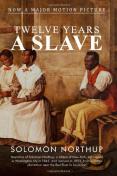BKMT READING GUIDES
12 Years a Slave: (Movie Tie-In) (Penguin Classics)
by Solomon Northup
Published: 2013-09-08
Paperback : 152 pages
Paperback : 152 pages
10 members reading this now
16 clubs reading this now
9 members have read this book
16 clubs reading this now
9 members have read this book
Twelve Years a Slave by Solomon Northup is a memoir of a black man who was born free in New York state but kidnapped, sold into slavery and kept in bondage for 12 years in Louisiana before the American Civil War. He provided details of slave markets in Washington, DC, as well as describing at ...
No other editions available.
Jump to
Introduction
Twelve Years a Slave by Solomon Northup is a memoir of a black man who was born free in New York state but kidnapped, sold into slavery and kept in bondage for 12 years in Louisiana before the American Civil War. He provided details of slave markets in Washington, DC, as well as describing at length cotton cultivation on major plantations in Louisiana.
Discussion Questions
Solomon Northup’s Twelve Years a Slave was one of some 150 so-called “Slave Narratives” published before the Civil War. Their purpose was to give the white Northerners a first-hand glimpse of slavery and to enlist them in the antislavery crusade. They were both literature and propaganda. What is the essence of Northup’s description of Southern slavery?One of the distinguishing features of Twelve Years a Slave is its specificity. Unlike most slave narratives, Northup did not employ pseudonyms for persons or places and rarely wrote in generalities. Northup also studiously avoided stereotypes: there are good masters and bad; slaves who resist and those who collapse before white power. Northup hoped that this frank portrayal would convince readers of the authenticity of his story. Does it? How does it achieve that aim?
After witnessing the brutalities not only of white masters against enslaved blacks, but also white brutality against other whites, Northup observed, “It is not the fault of the slaveholder that he is cruel, so much as it is the fault of the system under which he lives” (p. 135). Do you think this observation is accurate? Does it seem accurate to state that both whites and enslaved blacks that lived in the South were mutually affected by the system of slavery?
Although Northup says little directly about the struggle against slavery that is preoccupying the nation in the decade before the Civil War, Twelve Years a Slave is one of the most powerful weapons in the antislavery arsenal. What makes it so?
Another distinguishing mark of Twelve Years a Slave is the author’s free status. Most of the slave narratives-like that of Frederick Douglass, for example-were written by an author who had been born into slavery. How does Northup’s free status shape his narrative? How might it have influenced the book’s reception?
How does Northup depict black life in the North?
In the North, free black people lived in fear of kidnappers, who operated with near impunity in almost all Northern cities. Yet, Northup seems impervious to the possibilities that he might be targeted and that the offer to join a circus might be too good to be true. What might have made Northup miss the seemingly obvious danger?
Solomon Northup was a keen observer of human nature. Did his ability to discern people’s character build solidarity with his fellow slaves or did his analytic skills to observe how others dealt with the reality of enslavement distance him from the slave community? With what types of men and women did Northup find commonality or comradeship?
Solomon Northup never gave up hope of regaining his freedom and resisted the dehumanization of enslavement in many ways. How did he and other slaves resist slavery?
The family played a critical role in Northup’s life in both freedom and slavery. How does his portrayal of black family life shape his narrative and his critique of slavery?
Related to the emphasis on family life is the role played by women, black and white, in Northup’s narrative. In fact, females are among the most important characters in Twelve Years a Slave. How do women serve as a measure for the nature of slavery?
Describe the position of women within the slaveholding world. How would you characterize someone like Eliza or Patsy? What are the differences between the experiences of enslaved women and slaveholding mistresses like Mrs. Epps? Are women more or less vulnerable than men to the brutality of a slave society, or is it a different kind of vulnerability altogether? What advantages or disadvantages might enslaved women have over enslaved men?
Northup has a good deal to say about labor. What is his understanding of the nature of work, the development of a work ethic, the relations between employees and employers (in the North) and slave and masters (in the South), and the quality and productivity of labor in both sections?
Music plays a large role in Northup’s life. Northup’s omnipresent fiddle was a source of empowerment and a symbol of his subordination. What does the fiddle tell us about Northup and African American life in slavery and freedom?
Book Club Recommendations
Recommended to book clubs by 0 of 0 members.
MEMBER LOGIN
BECOME A MEMBER it's free
Now serving over 80,000 book clubs & ready to welcome yours. Join us and get the Top Book Club Picks of 2022 (so far).
SEARCH OUR READING GUIDES
Search
FEATURED EVENTS
PAST AUTHOR CHATS
JOIN OUR MAILING LIST
Get free weekly updates on top club picks, book giveaways, author events and more
Get free weekly updates on top club picks, book giveaways, author events and more
Please wait...








